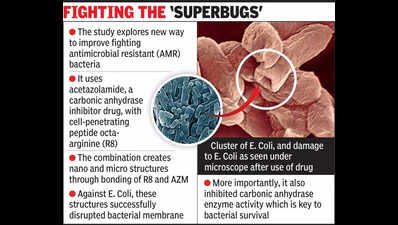- News
- IIT-Gn repurposes diuretic drug to fight resistant bacteria
IIT-Gn repurposes diuretic drug to fight resistant bacteria
Ahmedabad: Necessity, they say, is the mother of invention. With more and more bacteria turning resistant against the limited arsenal of antibiotics, antimicrobial resistance (AMR) has become a serious challenge nationally as well as globally – some estimates put the number of deaths attributed to ‘superbugs' with no cure in sight at about 10 lakh annually.
In such a scenario, IIT-Gn researchers have reported a breakthrough where they have turned a diuretic and anti-seizure medicine into a potent ‘antibiotic'. This chemical design potentially kills resistant E-coli, one of the most common bacterial infections worldwide.
Researchers from IIT-Gn chemically married acetazolamide – a diuretic which helps flush extra fluid and salts out of the body, which is also used to treat altitude sickness and certain seizures – with octa-arginine (R8) peptides to successfully target resistant E. Coli.
When merged, this combination had the ability to breach the bacterial wall and kill the E-Coli.
"This research is a breakthrough in the fight against AMR. We will now undertake further trials using this novel drug delivery system to test it against clinical strains with AMR," said Bhaskar Datta, associate professor of chemistry and biological sciences at IIT-Gn.
Professor Datta said that the trigger point of this research was the known ability of certain peptides called cell-penetrating peptides to create channels in human cells, through which other cargo molecules could be introduced inside the cell. "The research has proved the development of emergent antibacterial agents that combine an active pharmaceutical but non-antibacterial agent – acetazolamide – with a drug delivery strategy of using R8 peptide cell penetrating complex," Prof Datta said.
"This learning is helpful as it suggests that bacterial cells could be tricked into submission by use of such entities that are more than the sum of their individual parts," he added.
The researchers said that conventional drug development relies on the exploration of chemical agents to target biological substances such as specific proteins, enzymes and nucleic acids, that are directly associated with disease conditions. But they took a different approach where they created novel chemical structures not known to AMR bacteria.
In simpler terms, the drug-peptide complex successfully penetrates the bacteria membrane as the bacteria does not identify it as a potential threat.
The researchers said that it took them about three years to define various components of the method – physical complexes of molecules, cell-penetrating peptides, and optimal dose of pharmaceutical agents.
'Treatment of Escherichia coli with the complexes results in a distinctive pattern of membrane disruption and pore formation. The R8:AZM co-assemblies inhibit carbonic anhydrase and E. coli growth with greater efficiency compared to bare AZM. The 1:5 w/w complex leads to pronounced outer and inner membrane rupture and significantly restricts glucose uptake by E. Coli,' read the findings of the study.
End of Article
Follow Us On Social Media











